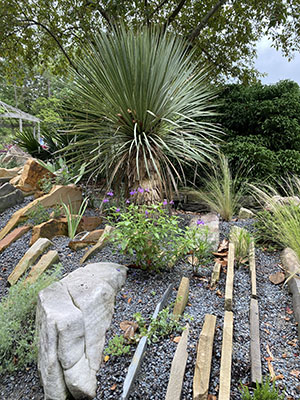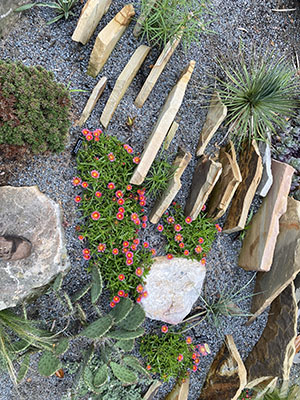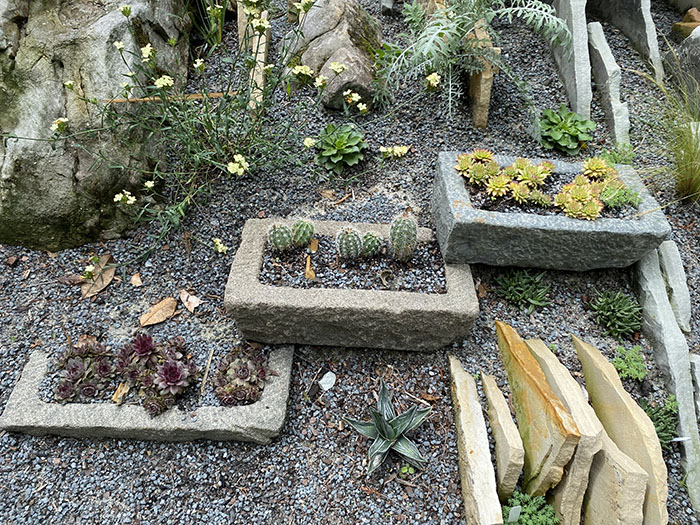Garden Talk
Try This, Not That: Crevice and Rock Gardening
By April Stradley
Historic Gardens Horticulturist

Have you ever found yourself scowling at a dandelion that has spontaneously burst out of a crack in your driveway? Have you ever found yourself comparing that happy weed to the struggling perennials or annuals in your carefully tended garden beds? Give the devil their due, those dandelions have always known what we gardeners are just catching on to: the magic of the crevice garden.
Crevice gardening is a style of rock gardening that utilizes the spaces between rocks as planting nooks, mimicking natural alpine conditions and creating microclimates that accommodate plants that might otherwise be impossible to grow in our humid Southeastern gardens. It’s all gardening enthusiasts have been able to talk about since August 2022, when Kenton Seth and Paul Spriggs published their instant classic how-to manual "The Crevice Garden," which popularized the concept and made it accessible to a wider audience. Now it’s the latest trend and new articles and podcast episodes about it are popping up all the time, sort of like how we all became obsessed with making bread at home during the pandemic.
There are lots of great reasons to try crevice gardening. Chiefly, playing with rocks is fun, as any toddler can verify. Other great reasons include the sustainability of low-water gardening practices, the beauty in the landscape, and the opportunity to include unusual plants in your collection to make your neighbors and friends jealous, like mangaves (showy hybrid agaves that are especially sought after by succulent aficionados).
As any gardener in the Piedmont knows, there are certain plants that struggle in our sticky clay soils. The soil stays too wet in the winter and gets too dry in the summer. It’s a frustrating reality. Crevice gardening solves that problem by creating slopes where water can run off quickly, and by using coarse materials like gravel, grit and stones instead of traditional soils and compost, allowing those plants to thrive.
Those of us who are used to kitchen gardens might find it hard to believe that there are plants that prefer poor, nutrient scarce, dry growing mediums, and that will suffer in rich soils. But not only do these plants exist, they are abundant, beautiful and exciting. Some are even native to the Southeast, like rattlesnake master (Eryngium yuccifolium) and the eastern prickly pear cactus (Opuntia humifusa). Many of these plants are adapted to the full, fierce, unimpeded sunlight of a high mountain slope, and these harsh conditions are present in many of our residential and urban landscapes—thin strips of lawn between a road and a sidewalk, for example, or a south-facing area near a brick or stone wall.

For plant geeks like me, crevice gardening offers an opportunity to learn about and experiment with fascinating ecosystems and plant communities with which I rarely interact. Crevice gardens can mimic a glacier-scoured alpine slope, a desert, maritime or Mediterranean landscape, or even a cliffside. One of the most interesting interpretations of a crevice garden, in my opinion, is the “ruin,” or human-made structure that has begun to crumble away as plants and animals take advantage of a recently vacated space. The possibilities are limited only by your imagination!
Are you already browsing search results for crevice gardens? Have I talked you into it? Hold your buckets, there’s a “but” coming.
Crevice gardens means using rocks and stones, and at the end of the day rocks and stones just want to be left alone. They don’t want to be moved, lifted, set at perfect angles, and made to stand pretty. You have to be persuasive with rocks. For us with the crevice garden in the Terrace Gardens, this meant using heavy equipment like tractors, excavators, front-end loaders, dump vehicles, straps, forklifts and human labor. I would estimate that we set over 50 tons of stone and boulders between August and December, not to mention soil, sand, PermaTill (a special kind of stone used as a soil amendment) and gravel. The entire project took eight months, start to finish, and it utilized the time, physical labor and creativity of five to seven horticulturists, one stone mason and many volunteers. Whatever the internet might want to tell you, there’s no way to DIY a home crevice garden in one day for under $50.
That doesn’t mean you have to miss out on this exciting trend. A fascinating and functional crevice, rock or scree garden can be created on a small scale in a raised bed, or inside a planter like a trough or a hypertufa container. An interesting option that can achieve effects similar to a crevice garden is a scree garden like we demonstrate within our Mary Duke Biddle Rose Garden. Incorporating raised beds and hypertufa containers can add height and depth to a traditional garden. Or, if you just can’t rest until you have a crevice garden of your own, this horticulturist strongly recommends hiring a professional contractor.
Whether you're looking for ideas or just curious about the concept, there are lots of opportunities to scope out crevice gardens in the Triangle area. Juniper Level Botanic Garden in Raleigh has an excellent crevice garden built decades before it became mainstream. If you have the chance to visit during one of their upcoming open garden days, I highly recommend it. While you're in Raleigh, you can also check out the J.C Raulston Arboretum, which has been building crevice, scree and rock gardens as well. Meanwhile, here at Sarah P. Duke Gardens, we just finished constructing and planting our crevice garden in the Terrace Gardens, and I am very excited to see how the plants respond this summer. Hope to see you there!
Learn more: April Stradley will teach “Try This, Not That: Crevice and Rock Gardening” on site at Duke Gardens on Tuesday, June 6, from 2:30 to 4 p.m. The program is for gardeners or aspiring gardeners at all levels. Read more about this class and others on our program registration site.
Photos from top: A rock garden featuring native plants in between the President's Bridge gate and the south entrance to the Blomquist Garden of Native Plants; a beaked yucca (Yucca rostrata) in the new crevice garden in the Terrace Gardens; cacti and other succulents grow amidst sheets of sandstone in the Terrace Gardens; hypertufa troughs containing succulents in the Historic Gardens. Photos by April Stradley.







